The outdoor exhibition covers an area of more than 1.5 hectares. The main part is located in front of the Tropicana greenhouse (most of the exhibits), while the second part is located around the administrative building (rock garden and kitchen garden). Similar to the greenhouses, the outdoor section is largely divided geographically or into collections of different groups of plants.
The beds of the outdoor exhibition are designed with various forms of plants. Most of them are based on woody plants and perennials, which are supplemented during the summer by delicate species stored over the winter in the background and annuals. In this way, it is possible to show visitors exotic plants that would otherwise have to be kept in cold greenhouses.
| Number of taxa | Number of gardeners |
|---|---|
| 5,100 | 8 |
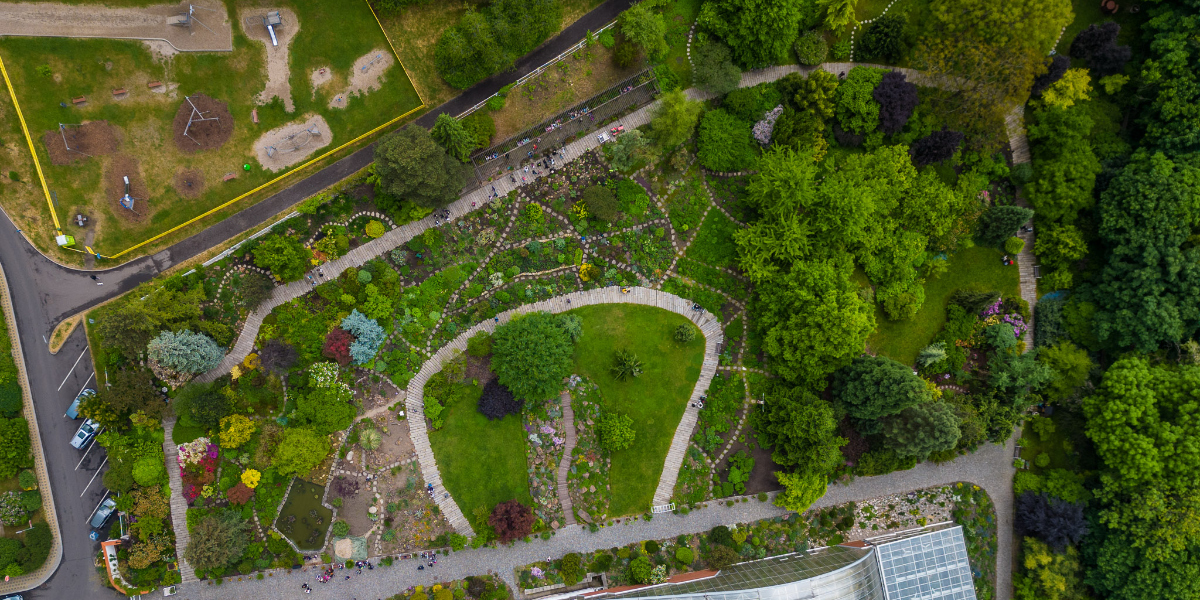
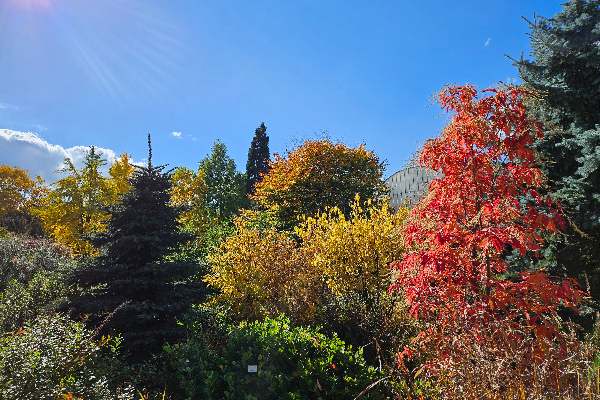
The peat bogs of North America are wetland habitats that form on acidic, nutrient-poor soils. This has led to the development of carnivorous plants, such as the planted pitcher plants (Sarracenia). However, this section also features interesting woody plants that dye their leaves a rich yellow (Fothergilla major) or dark orange (Oxydendrum arboreum). The summer months are brightened by moisture-loving lobelias (Lobelia). The exhibition is accompanied by a wooden sculpture of a North American alligator.
Ideal time to visit: May–October
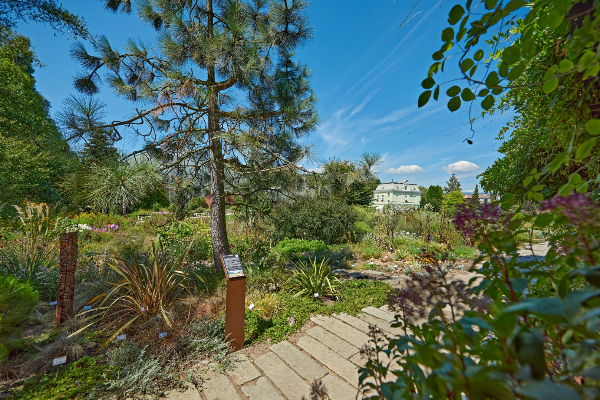
For us, the most distant continent is often associated with subtropical and tropical plants that are difficult to grow in greenhouse conditions. Some southern regions (e.g., Tasmania or New Zealand) are home to flora that is accustomed to certain winter conditions in its native habitat. You can admire evergreen hebes (Hebe), various species of sedges (Carex), and frost-resistant eucalyptus (Eucalyptus neglecta). The summer months are brightened by annuals such as strawflowers (Helichrysum, Rhodanthe), fan flowers (Scaevola), and wireflowers (Leucophyta).
Ideal time to visit: May–October
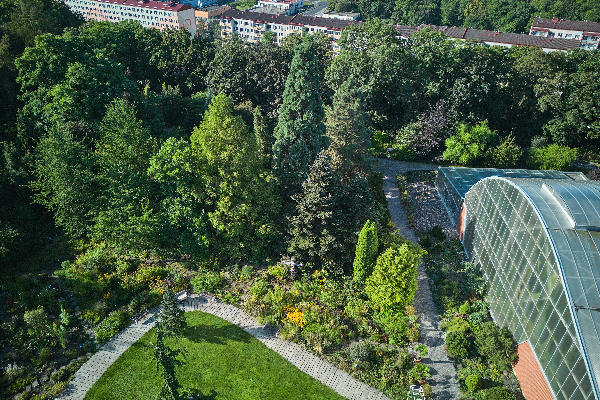
An important part of the entire outdoor exhibition are the trees, which form the main framework and dominant feature. Most of the trees are concentrated in the rear part of the outdoor exhibition, where individual paths will lead you. Visitors can admire two specimens of the species Gymnocladus dioica, which are more than a hundred years old. The autumn colors of the ginkgo biloba (Gingko biloba), Japanese maple (Acer palmatum), and Chinese dawn redwood (Metasequoia glyptostroboides) are particularly striking. And that's not all, because there are more than 500 different tree taxa in the outdoor area.
Ideal time to visit: all year round
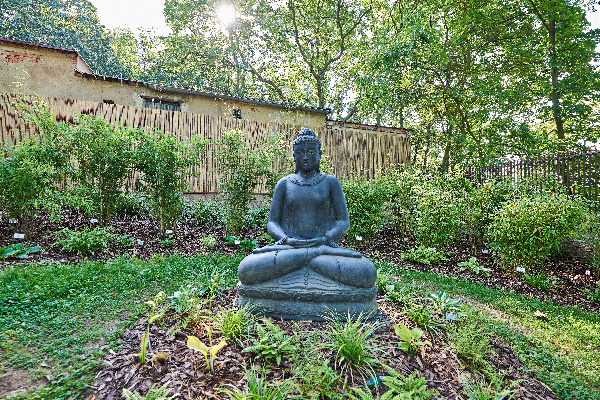
The bamboo garden was established in 2024 and consists mainly of various species and cultivars of the genus Fargesia. These are characterized not only by their interesting stems, but also by their slower growth and the desirable trait of not spreading sideways. The bamboos are complemented by other shade-loving perennials such as hostas (Hosta), sedges (Carex), and selected species of ferns. The central motif is a statue of Buddha, which will fulfill all your unspoken wishes.
Ideal time to visit: all year round
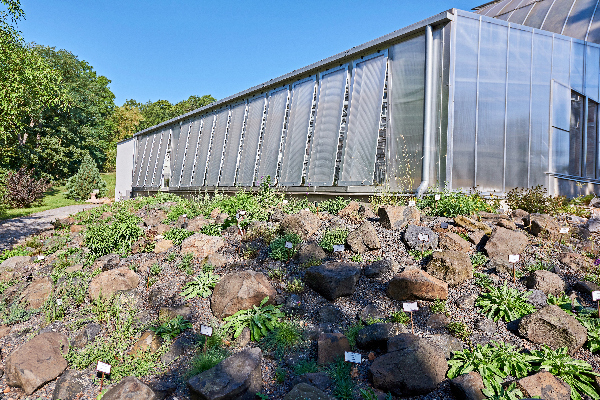
A basalt rock garden dedicated to the Czech Central Mountains was built between 2023 and 2024, with the first plantings carried out in 2024. It mainly features attractive and endangered species from the Louny Central Mountains. The rock garden serves as a collection of plants representing the nearest significant protected landscape area near Teplice and also as a repository for the gene pool of endangered plant species. In spring, the rock saxifrage (Aurinia saxatilis) shines yellow, the alpine aster (Aster alpinus) shines purple, and this is followed by the beautiful purple mullein (Verbascum phoeniceum) and blue Austrian flax (Linum austriacum).
Ideal time to visit: April–July
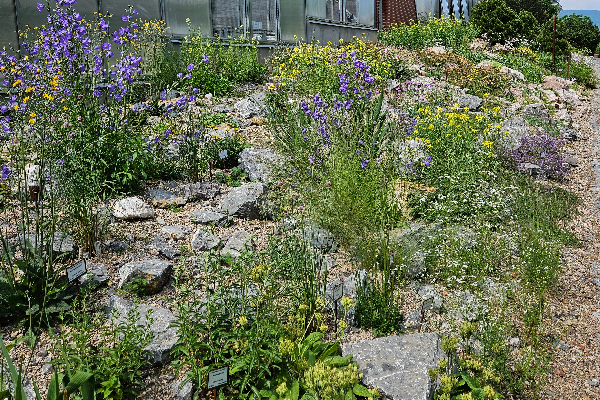
A smaller part of the limestone rock garden is dedicated to plants from the Bohemian Karst. In addition to representing this biotope, it also serves to preserve gene pool collections. In spring, the leafless iris (Iris aphylla) and hairy inula (Inula hirta) bloom. A plant endemic to the Czech Republic, the Karst rowan (Sorbus eximia), has also been planted here. The rock garden is intended to preserve the gene pool of the critically endangered Austrian dragonhead (Dracocephalum austriacum), which was planted in the garden's back area several years ago.
Ideal time to visit: April–July
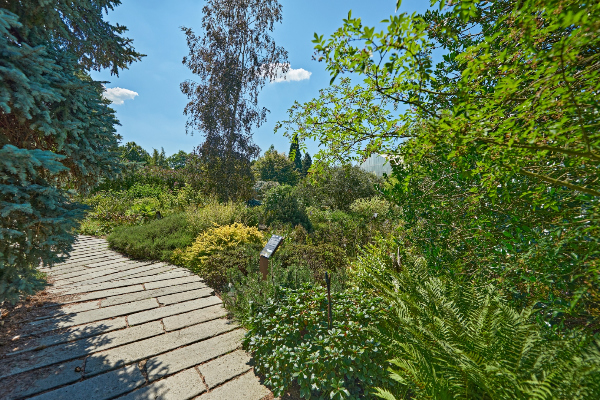
An exhibition presenting moisture-loving and acid-loving plants of Europe and Asia. Both heather (Calluna) and heath (Erica) are present, accompanied by cranberries (Vaccinium) and yellow-flowering globeflowers (Trollius). The atmosphere is completed by mountain pine (Pinus mugo) and several species of rhododendron (Rhododendron). In the future, a complete reconstruction of this part is planned, focusing on the peat bogs of the Ore Mountains and, possibly, the Czech Republic in general.
Ideal time to visit: April–October
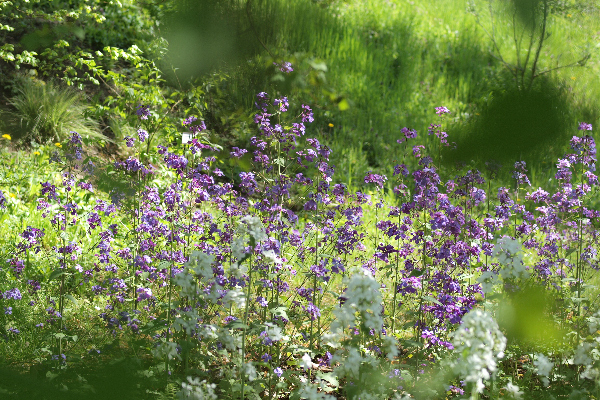
The undergrowth of forest formations is at its most enchanting in spring, when early-flowering plants bloom, taking advantage of the time when the trees are not yet in leaf. It is here that you can admire the wood anemone (Anemone nemorosa), the forest anemone (Anemone sylvestris), the lesser celandine (Ficaria verna), snowdrops (Galanthus), and the liverwort (Hepatica nobilis). Later, spring vetchling (Lathyrus vernus), lungwort (Pulmonaria), and sweet violet (Viola odorata) join them.
Ideal time to visit: March–May

The South American country of Chile, stretching 4,500 km along the Pacific coast from the borders with Peru and Bolivia to Tierra del Fuego (which it shares with Argentina), is extremely diverse in terms of vegetation. In the northwest lies the driest place on earth – the Atacama Desert. In some places, only 2 mm of rain falls annually, elsewhere even less, and heavier rainfall occurs approximately once every twelve years. Bromeliads (Bromeliaceae) are typical plants throughout South America. Puya berteroniana, which grows here, reaches a height of up to three meters when in bloom and is one of the largest of the thirty Chilean bromeliads. Tall grasses (Cortaderia) are also dominant, associated with rare wet areas. Abundant genera include shrubby Senna, succulent Cistanthe, cacti, succulents, and Nolana.
Ideal time to visit: June–September
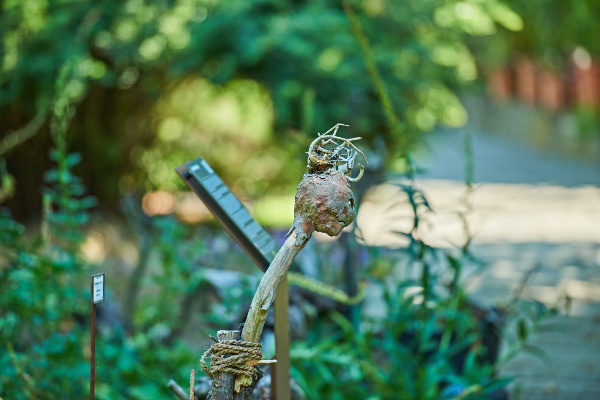
This part of the garden attracts all visitors like a magnet. The twisted branches forming its border and the ominous skulls evoke the feeling that something different awaits here. The Poison Garden features truly poisonous plants that even the notorious poisoner Giulia Tofana would be proud of. In spring, monkshood (Aconitum), spring pheasant's eye (Adonis vernalis), and snowdrops (Galanthus) reign supreme here. In summer, foxgloves (Digitalis), belladonna (Atropa), and datura (Datura) attract attention. Autumn ends with beautiful cultivars of deadly poisonous colchicum (Colchicum).
Ideal time to visit: February–October
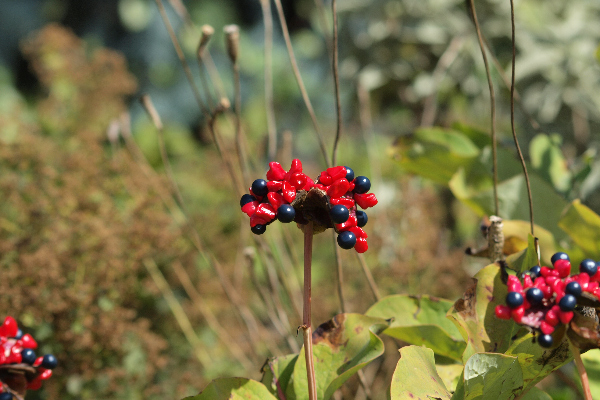
This exhibit is a small preview of the large section dedicated to the Mediterranean, as it presents plants from areas stretching from the Black Sea and the Caucasus Mountains to the Mediterranean and Aegean Seas. Thanks to this wide area, there are diverse climatic conditions and vegetation. In spring, bluebells (Scilla), peonies (Paeonia), and fritillaries (Fritillaria) attract attention. In summer, giant solitary bees can be observed on flowering phlomis (Phlomis).
Ideal time to visit: March–September
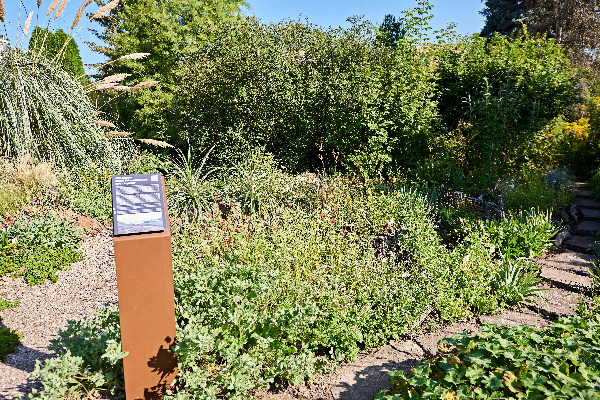
The foothills and mountainous regions of the Andes can be characterized by a more humid climate, which suits a different composition of plants than you will find in the Atacama Desert exhibit. Some smaller plant species are annuals, but most of them are perennials. The slipper flower (Calceolaria) grows on dry slopes, decorating the exhibit with its characteristic flowers, from which the genus got its Czech name. Other plants include the badil (Sisyrinchium), which is related to the well-known irises, and the loasa (Loasa) with stinging hairs on its stem and leaves.
Ideal time to visit: June–September
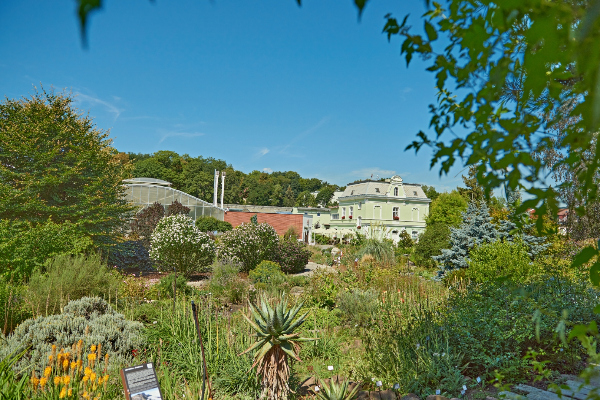
On the border between the South African province of KwaZulu-Natal, Lesotho, and Swaziland lies the Drakensberg mountain range, characterized by mountain steppe vegetation. The climate is influenced by altitude, and many plants can be successfully grown in the Czech Republic. Important cultivated genera include Berkheya, Kniphofia, Helichrysum, and Senecio. Succulents such as Aloe and creeping Delosperma are also found in this area.
Ideal time to visit: June–September
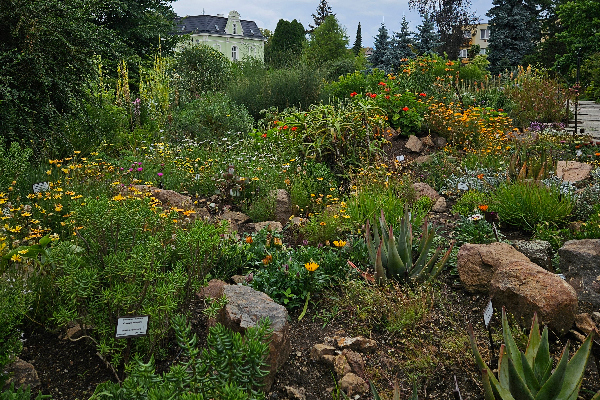
Capensis, or the Cape Floristic Region, is located in the south of South Africa. The typical vegetation is fynbos, consisting of evergreen shrubs, and is a South African equivalent of Mediterranean maquis. Characteristic groups of plants with fleshy succulent leaves include Aizoaceae and Crassulaceae. Asteraceae plants such as Arctotis, Gazania, and Ursinia are also abundant. Various species of geraniums (Pelargonium) and medicinal plants used by the indigenous people also originate from this area.
Ideal time to visit: June–September
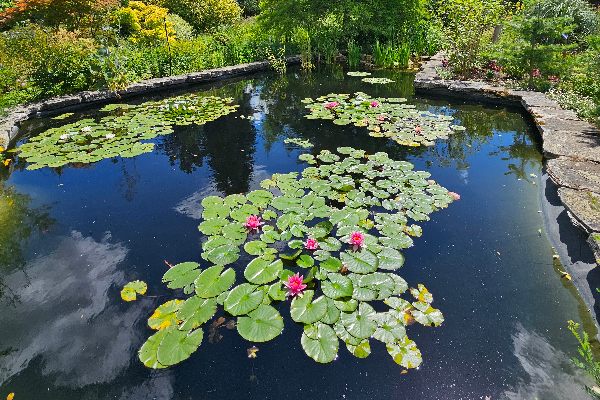
The pond is a peaceful spot surrounded by littoral plants that naturally purify the water and create a harmonious environment for other life. In summer, colourful cultivars of water lilies bloom on the surface, adding charm to the scene. During the warm months, the pond becomes a home for many insect species that find food and shelter here. A regular resident is also Žofka the grass snake, who enjoys basking and exploring her small watery kingdom.
Ideal time to visit: June–September
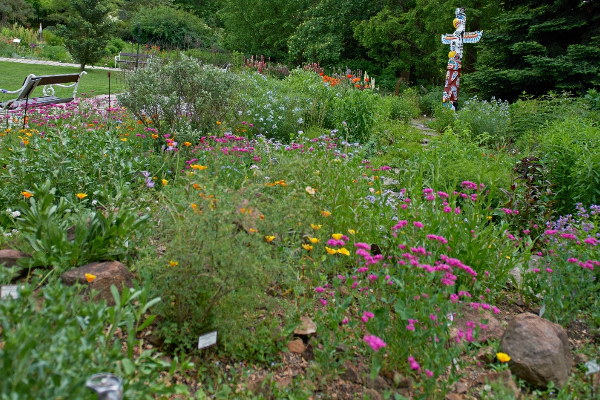
California, the third largest state in the USA, is located on the west coast. The climate conditions are specific and characterized by a Mediterranean type of climate. The exhibition is small and aims to show that the flora of this part of North America differs significantly from the rest. The state flower of California is the California poppy (Eschscholzia californica). Other important genera include argemone (Argemone), penstemon (Penstemon), and sage (Salvia). The dominant plant is the false indigo bush (Amorpha), which is often planted in the median strip of highways in the Czech Republic.
Ideal time to visit: May–July
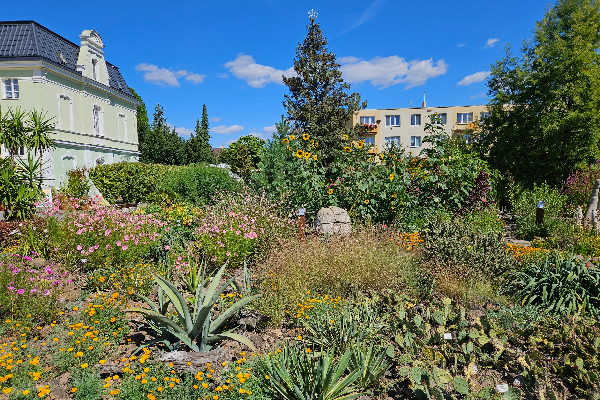
Mexico is one of the most biologically diverse countries in the world. The vegetation of Mexico in dry and warm areas consists of forests (pine in higher elevations, oak in lower elevations) and dry shrubbery with a high proportion of cacti (Cactaceae). The agave genus (Agave) has its center of development here, and plants from the Asteraceae family are scattered throughout the vegetation – marigolds (Tagetes) and other well-known genera (sunflowers – Helianthus, dahlias – Dahlia, cosmos – Cosmos, zinnias – Zinnia). The sage genus (Salvia) is also well represented. In the exhibition, you can admire frost-resistant yuccas (Yucca), which bloom in early summer, as well as brown-spined prickly pears (Opuntia phaecantha). Peppers, corn, and tomatoes, which are common today, also originate from Mexico.
Ideal time to visit: June–September
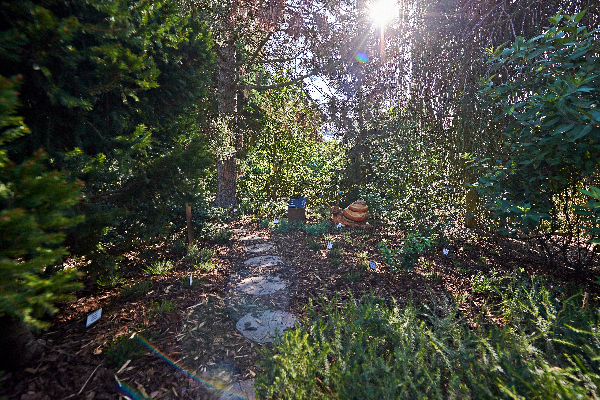
This is not just a collection of heather plants (Ericaceae family), but the exhibition is also supplemented with other perennials, such as ferns, sedges (Carex) and grasses (Poaceae). The genus Erica comprises an incredible 860 species. Our exhibition features Erica tetralix from the Atlantic regions of Europe, which is classified as a critically endangered species in our country. Erica carnea is one of the most commonly sold heathers. It is also widespread in the Czech Republic and classified as an endangered species. We also exhibit two hybrids, Erica ×darleyensis and Erica ×krameri.
Ideal time to visit: all year round
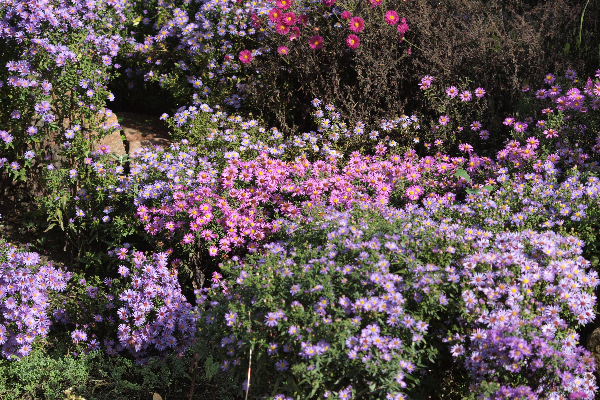
Our collection focuses on the breeding of perennial autumn asters by Rudolf Votruba from the Silva Tarouca Research Institute for Landscape and Ornamental Horticulture in Průhonice. The aim of his breeding was to obtain varieties resistant to powdery mildew. Resistance to powdery mildew was monitored after artificial infection in a greenhouse, and plants with the least infestation were subsequently selected. In addition to Czech breeding, we also present other representatives of these beautiful autumn perennials. The New England aster (Symphyotrichum novae-angliae) is characterized by a rough, hairy stem. During vegetation, the leaves at the bottom of the stem dry out. New Belgium coneflower (Symphyotrichum novi-belgii), on the other hand, has smooth, shiny, hairless stems. It is a shorter species that requires moister soil and is also more susceptible to powdery mildew.
Ideal time to visit: September–October
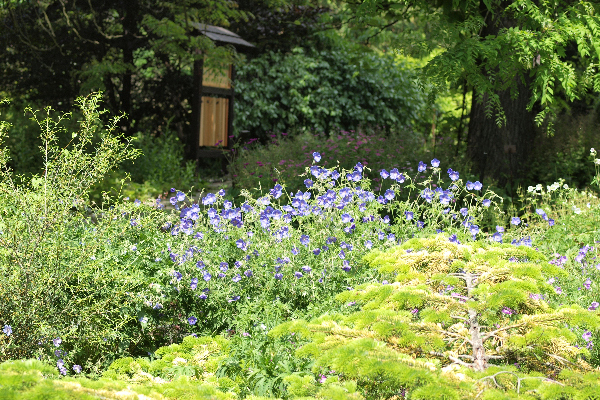
The cultivation of cranesbill (Geranium) has a long tradition in Czech gardens. Its history dates back to the 16th century, when geranium essential oils were extracted from cranesbill leaves, which are still used today as a basic raw material for the production of fragrant oils. Many species occurred naturally in rural gardens and parks. These plants are ideal for group plantings as ground cover plants in sun and partial shade, in dry and wet conditions; you just need to choose the right species and cultivar.
Ideal time to visit: May–June flowering/all year round
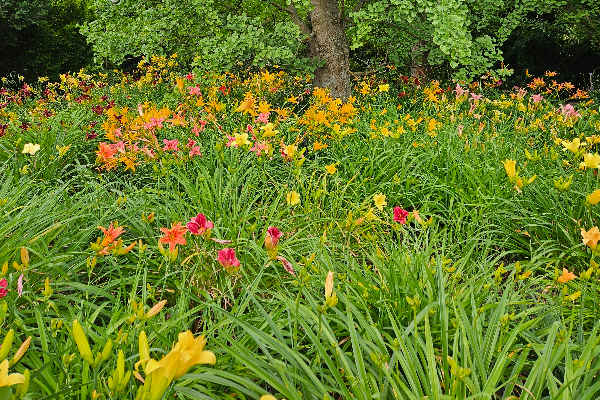
Among the treasures of the garden are daylilies (Hemerocallis), which resemble lilies but are less demanding. Each flower lasts only one day (hence their name, loosely translated from Greek as "one-day beauty"), but the plant has many flowers in its inflorescence, which bloom gradually. Individual daylily cultivars differ mainly in flower color, flowering time, and plant height. There are over 50,000 known cultivars, but our garden presents only a fraction of them, with 165 cultivars on display.
Ideal time to visit: June–July
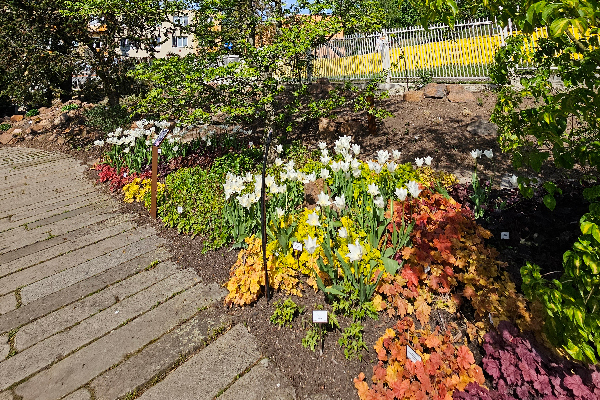
Perennials that brighten up every corner of the garden with their colorful leaves. They are also excellent as ground cover plants under trees or shrubs. These are coral bells (Heuchera). They are grown primarily for their decorative leaves in shades of gold, red, or silver, which persist throughout the winter, making the plants attractive all year round. Between June and August, the colorful leaves are complemented by inflorescences composed of white, pink, or fiery red bell-shaped flowers. Heuchera are native to North America.
Ideal time to visit: all year round
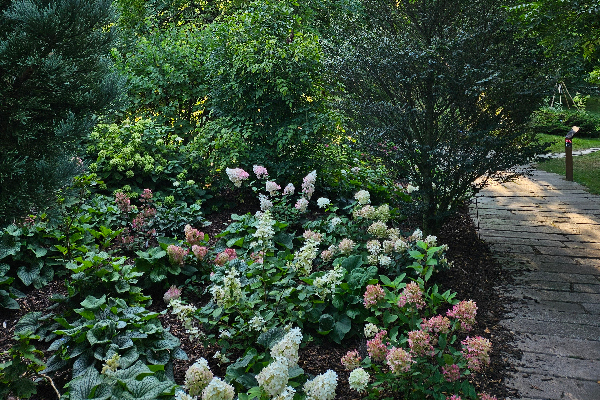
Hydrangea is a genus of plants in the Hydrangeaceae family, comprising 96 recognized species growing mainly in Asia, but also in North and South America. Today, they are popular ornamental plants, with the most widespread being the bigleaf hydrangea (Hydrangea macrophylla), of which over 600 different cultivars have been bred. Other cultivated species include the panicle hydrangea (Hydrangea paniculata), the tree hydrangea (Hydrangea arborescens), and the oakleaf hydrangea (Hydrangea quercifolia).
Ideal time to visit: May–October
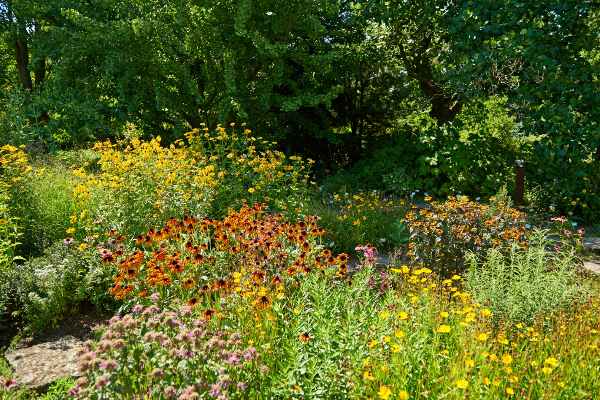
Many popular garden perennials originate from North America, and so a large part of the exhibition is devoted to plants from the USA and Canada. Most of these plants come from prairie communities in central and western North America, while some grow on the slopes of the Rocky Mountains or the Appalachian Mountains. The exhibition features genera such as Penstemon, Gaillardia, Coreopsis, Phlox, Echinacea, and Rudbeckia. Many interesting herbs grow in the shade of the forest, and the rear part of the flowerbed is dedicated to them, with genera such as Heuchera, Primula (syn. Dodecatheon), and Actaea.
Ideal time to visit: May–October
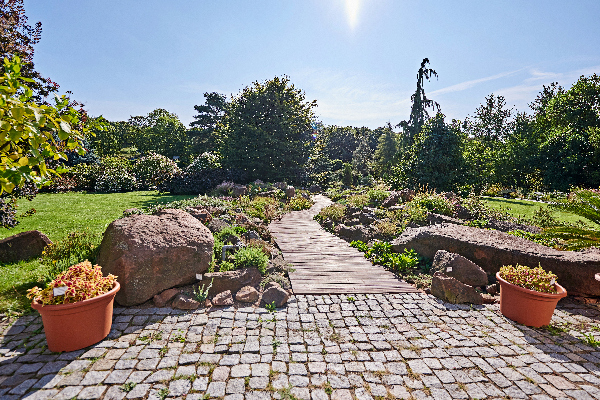
Rock gardens, or alpine gardens, attempt to mimic real mountain habitats in the wild by planting plants that colonize these sometimes inhospitable environments. The plants must cope with a short growing season, excessive sunlight, and a lack of moisture. Dwarf trees and mountain plants from Europe and Asia are planted mainly on the rock garden bordering the greenhouse, while mountain plants from North America and southern Europe are planted on the rock garden located in the central lawn. A smaller rock garden with a water feature is located near the café.
Ideal time to visit: all year round
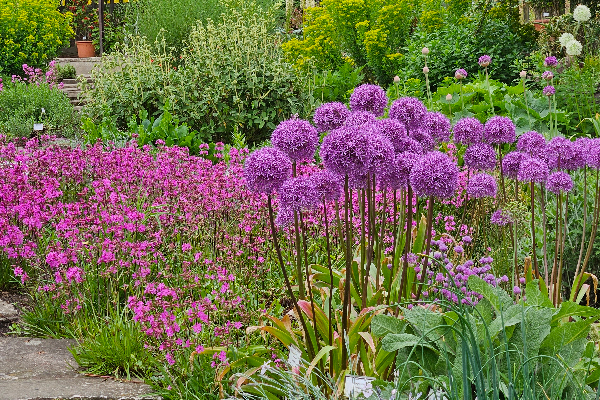
Central Asia, geographically speaking, refers to countries such as Kazakhstan and Uzbekistan. These areas are home to an abundance of bulbous plants such as wild forms of tulips (Tulipa) and garlic (Allium), many of which have been cultivated and are very popular among gardeners thanks to their decorative inflorescences. They are complemented by cultivars of oriental poppy (Papaver orientale) and other members of the sage family (Salvia). Rhubarb (Rheum) also grows in Central Asia, and the original cannabis plants (Cannabis) originate from here.
Ideal time to visit: March–June
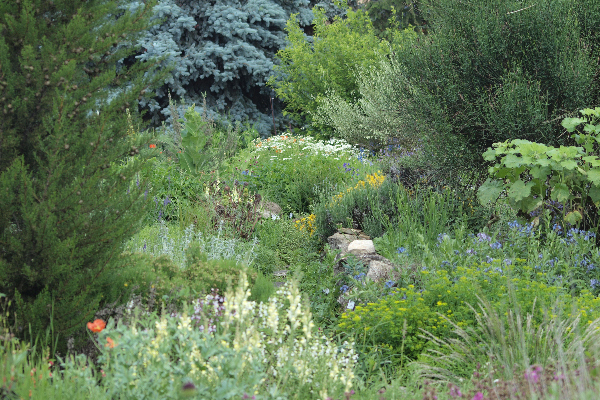
The Mediterranean (also referred to as the Mediterranean region) defines the area around the Mediterranean Sea. It is characterized by mild, humid winters and hot, dry summers. Mediterranean vegetation consists mainly of hard-leaved trees (especially shrubs, known as macchia). A typical family is the Lamiaceae – who doesn't know lavender (Lavandula), sage (Salvia), thyme (Thymus) and other plants containing essential oils.
Ideal time to visit: April–July
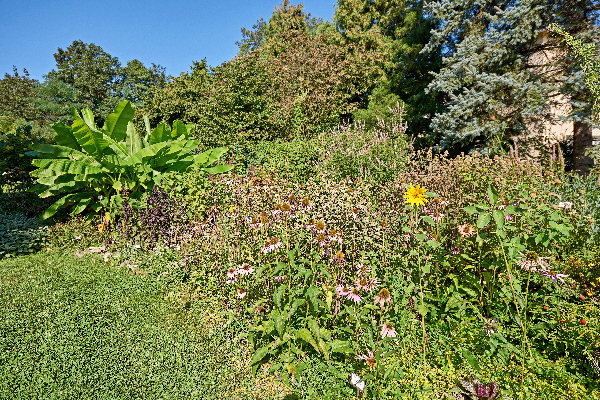
One of the most popular exhibits among visitors. It is also called the herb garden, but since this exhibit contains not only herbs but also many useful plants, the general name is appropriate. In addition to classic herbs such as basil (Ocimum), oregano (Origanum), lavender (Lavandula), and sage (Salvia), there are also interesting useful plants from traditional Chinese medicine (Eleutherococcus senticosus), African medicine (Leonotis nepetifolia), and useful plants such as unusual cultivars of tomatoes (Solanum), strawberries (Fragaria), and blackberries (Rubus).
Ideal time to visit: April–October
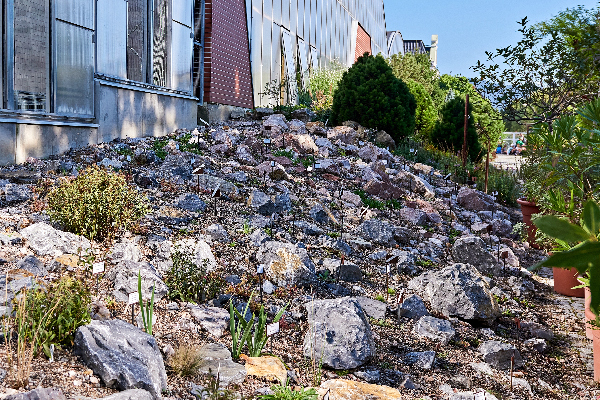
The limestone areas of the Alps mainly include the Northern Limestone Alps and the Southern Limestone Alps, where rocks deposited during the Mesozoic era predominate. The vegetation of the Alps is very diverse and includes a large number of endemic species. Among the interesting species, we try to show visitors the alpine edelweiss (Leontopodium nivale subsp. alpinum) and the iconic mountain avens (Dryas octopetala).
Ideal time to visit: March–October
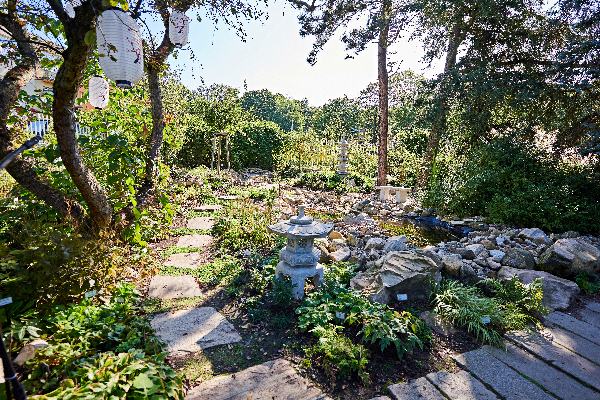
East Asia is a vast region, and our exhibition presents a cross-section of the most interesting perennials from China, Japan, and the Korean Peninsula. The newest part, with a stream, pond, and bamboo, has a calming effect, while sunny spots are reserved for perennials that require more light, and the rock garden features representatives of the Hylotelephium genus. In winter, the massive Chinese silver grass (Miscanthus sinensis) catches the eye. Among the perennials, we grow astilbes (Astilbe), barrenwort (Epimedium), and balloon flowers (Platycodon).
Ideal time to visit: April–October